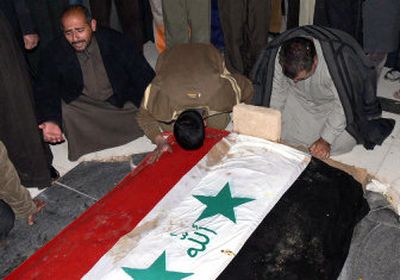Execution video inflames Sunnis

BAGHDAD, Iraq – Hundreds of supporters of Saddam Hussein broke curfew Sunday to pay respects at the tomb of the toppled Iraqi president, who was buried before daybreak in the small northern town where he was born.
At the funeral in Ouja and across the Sunni Arab world, Saddam’s co-religionists expressed outrage at his chaotic final moments, revealed in grainy footage circulated widely on the Internet and on television showing his execution at dawn on Saturday.
The video, which appears to have been recorded with a cell phone, showed onlookers taunting Saddam with chants of “Muqtada, Muqtada, Muqtada,” a reference to radical Shiite Muslim cleric Muqtada al-Sadr, whose Mahdi militia is accused of hunting down Sunni Arabs and killing them. As the trap door snapped open beneath Saddam, some in attendance cheered: “The tyrant has fallen!”
The spectacle appeared to deepen deadly sectarian divide between Sunni Arabs and the Shiite majority that now leads Iraq’s government.
“Today they proved themselves that the trial and the execution were mere retaliation and not justice,” said a mourner from Saddam’s hometown of Tikrit, who gave his name only as Abu Mohammed, a customary nickname. “It is clear now against whom we should retaliate.”
As the images ricocheted across the Arab world, they drew angry comment in newspapers, on television and on Internet blogs in Saudi Arabia, Jordan, Egypt and other heavily Sunni countries that are allies of the United States.
Hisham Melhem, the pro-American spokesman for the Arabic satellite news station Al-Arabiya, called the execution a total disaster in an interview on CNN and described the future for Iraq as “descending into a black hole.”
Many blamed the United States, which had custody of Saddam, for handing him over to the Iraqi government to be humiliated before his death. U.S. officials in Baghdad had no comment, and at the White House, a spokesman had no further comment beyond a written statement by President Bush on Friday night in which he called the execution “an important milestone” that came after a “fair trial.”
Saddam was convicted of crimes against humanity for ordering the executions of 148 men and boys in the Shiite town of Dujayl where he was the target of a failed 1982 assassination attempt. He was hanged days after an appeals panel upheld the sentence.
Iraqi government officials said they never intended the execution to be shown publicly in its entirety. They released only a brief video excerpt to head off skeptics who might not believe Saddam was really gone, they said.
Scores of demonstrators carrying Saddam’s picture marched through Ramadi and Hawija to vent their anger Sunday, and funeral tents were erected in a number of Sunni Arab towns to receive mourners.
After the hanging, the body of Saddam, 69, was washed and wrapped in a white shroud according to Islamic tradition and transported in a U.S. military helicopter to Tikrit.
The provincial governor and the head of Saddam’s Albu-Nassir clan then loaded Saddam’s coffin onto the back of a white police pickup truck and drove it to his birthplace in nearby Ouja.
It was placed in what was described as a temporary grave prepared in a religious hall about two miles from the cemetery where Saddam’s sons, Uday and Qusay, were buried after they died in a gunfight with U.S. forces in Mosul in 2003.
It is not yet known where a permanent grave may be situated. Elders did not want to bury Saddam with his sons in the less-centrally-located cemetery for fear that the grave would be desecrated.